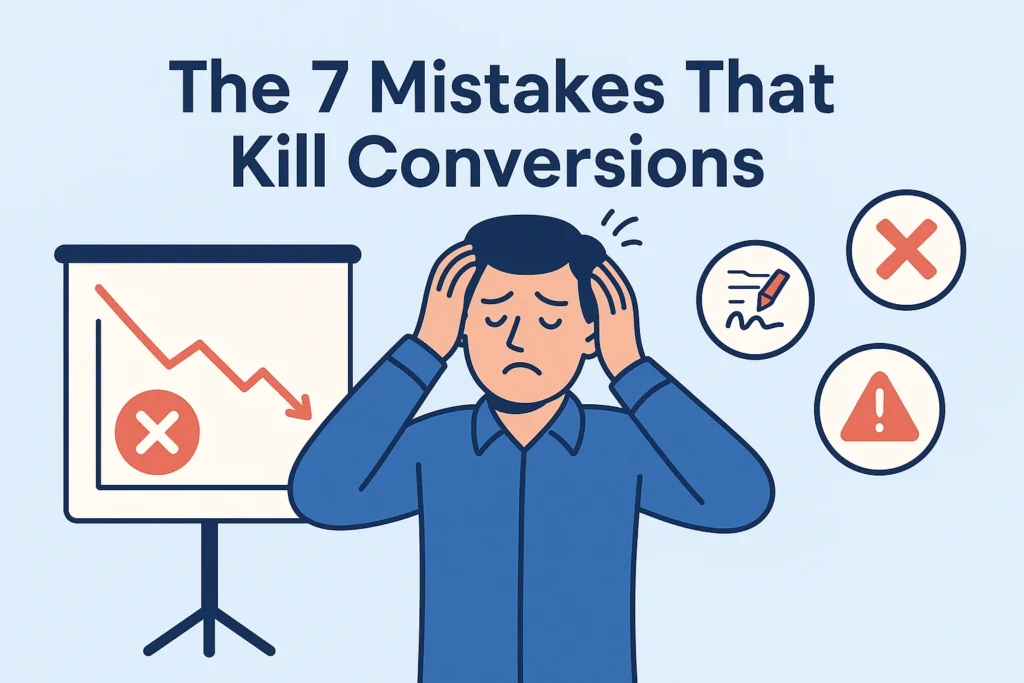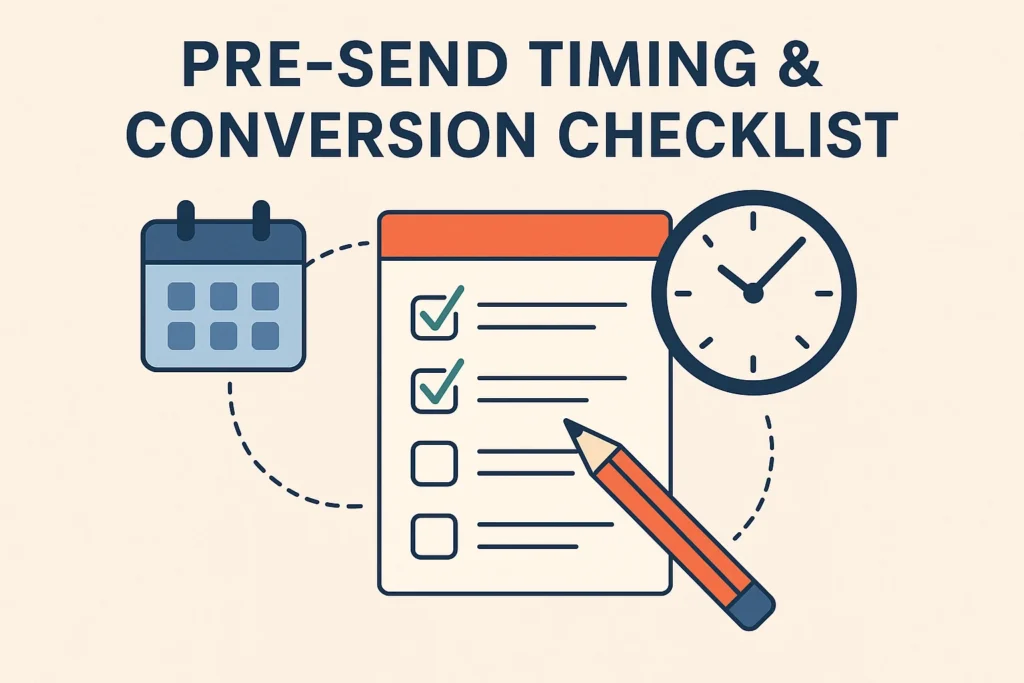The Best Time to Send Marketing Emails — and 7 Mistakes That Kill Conversions
Ever sent an email campaign that felt perfect — strong subject line, great design, irresistible offer — yet the results fell flat?
You’re not alone.
Across industries, more than 60% of marketing emails are never opened, and an even smaller fraction converts. Most of the time, it’s not your offer or design that’s the problem — it’s when you send and how you send it.
In this comprehensive guide, you’ll discover:
- The data-backed best times and days to send marketing emails in 2025.
- Why “best time” isn’t universal, and how to find what works for your audience.
- The 7 biggest email marketing mistakes that silently destroy conversions.
- A practical testing and optimization framework to boost results.
Let’s turn timing from a guessing game into a data-driven advantage.
1️⃣ Why Send Time Really Matters
Email timing isn’t just about convenience — it’s about psychology.
When your message hits the inbox determines whether it gets opened, ignored, or buried under a flood of competing promotions.
📊 The Data Behind Timing
| Metric | Good Benchmark | Why It Matters |
|---|---|---|
| Average open rate | 30–35% | Email relevance + timing synergy |
| Average click-through rate | 3–5% | The higher your CTR, the stronger your timing & messaging alignment |
| Emails opened within 1 hour of arrival | ~23% | Proves timing drives visibility |
A one-hour delay in delivery can move your email from “top of inbox” to “lost forever.”
🧠 The Psychology of Attention
Your subscribers’ inboxes are decision funnels.
People tend to check emails at habitual times — often right after waking up, during breaks, or before ending their workday.
If you’re not in that window, your message gets mentally filtered out.
That’s why optimizing timing can increase open rates by up to 50% — even before changing your subject line or design.
2️⃣ What Current Data Says: Best Times & Days
Let’s start with aggregated, cross-industry research.
📅 Best Days to Send Marketing Emails
| Rank | Day | Engagement Reason |
|---|---|---|
| 1️⃣ | Tuesday | Peak productivity day; subscribers are in “planning mode.” |
| 2️⃣ | Thursday | Momentum midweek; less inbox competition than Friday. |
| 3️⃣ | Wednesday | Solid performer for B2B content and newsletters. |
| 🚫 | Monday / Friday | Monday = catch-up chaos, Friday = mentally checked-out audiences. |
| ⚠️ | Weekends | Highly niche-dependent — lifestyle brands may perform better. |
⏰ Best Times of Day (Global Benchmarks)
| Time (Local) | Why It Works |
|---|---|
| 8:00–10:00 a.m. | Inbox-checking time for professionals before work meetings. |
| 1:00–3:00 p.m. | Post-lunch lull when users check inbox casually. |
| 4:00–6:00 p.m. | “End-of-day scroll” — good for e-commerce or casual reads. |
| 8:00–10:00 p.m. | Works for lifestyle/newsletter content — minimal competition. |
📈 According to AWeber’s 2024 Email Marketing Report, emails sent between 9–10 a.m. on Tuesday or Thursday saw 32% higher engagement than average.
But — and this is crucial — “best time” is a starting point, not a rule.
3️⃣ Why “Best Time” Isn’t Universal
Here’s where many marketers go wrong: they follow general benchmarks blindly.
Your list is not “average.”
⚙️ Factors That Shift Optimal Send Times
- Audience Type (B2B vs. B2C)
- B2B: Mornings (7–10 a.m.) perform better.
- B2C: Evenings (6–9 p.m.) often drive higher click rates.
- Geography & Time Zone
- If you serve multiple regions, segment by time zone.
- Sending “9 a.m.” in your time zone could mean “2 a.m.” elsewhere.
- Device Habits
- 60%+ of emails are opened on mobile.
- Mobile audiences are more active during commute hours and evenings.
- Frequency of Sending
- The more often you email, the less dependent you are on a single “perfect time.”
🔍 How to Find Your Best Send Time: 4-Week Testing Plan
| Week | Test Variable | Segment | Example |
|---|---|---|---|
| 1 | Morning (8–10 a.m.) vs Afternoon (1–3 p.m.) | Full list | Compare open rates |
| 2 | Tuesday vs Thursday | Full list | Compare CTRs |
| 3 | Weekend vs Weekday | Lifestyle segment | Identify outliers |
| 4 | Narrow winning window | Split by 1-hour increments | Fine-tune |
Document everything in a spreadsheet or CRM report.
After four weeks, you’ll have your personal “send-time fingerprint.”
4️⃣ The 7 Mistakes That Kill Conversions (and How to Fix Them)

Even perfect timing can’t fix poor execution.
Let’s uncover the seven mistakes that silently destroy email performance — and how to correct each one.
Mistake #1: Generic Subject Lines
Your subject line is your handshake. If it’s weak, no one opens the door.
Why It Hurts:
Bland, non-specific subject lines fail to trigger curiosity or relevance.
Fix It:
Use one of these proven subject frameworks:
- Curiosity: “You missed something big this morning…”
- Benefit: “Boost your ROI in 10 minutes a week”
- Question: “Are you sending your emails at the wrong time?”
Keep it under 45 characters for mobile visibility.
Mistake #2: Poor Segmentation
Sending every email to everyone is like shouting in a crowded room.
Why It Hurts:
Unsegmented lists reduce relevance, lower engagement, and increase unsubscribes.
Fix It:
Segment by:
- Behavior (opened last campaign vs. inactive)
- Interests (product type or topic)
- Lifecycle stage (new subscriber, active customer, churned user)
Example: send your “best time” test emails to active subscribers only — not dormant ones skewing the data.
Mistake #3: Ignoring Deliverability
You could have perfect timing — but if your email lands in spam, it’s worthless.
Why It Hurts:
Low sender reputation and missing authentication protocols block deliverability.
Fix It:
- Authenticate your domain with SPF, DKIM, and DMARC.
- Use a consistent “from” address.
- Avoid spam-trigger words (“Free!!!”, “Act Now”, “Guarantee”).
- Warm up new sending domains slowly.
Mistake #4: Overloading With CTAs
Multiple calls-to-action create friction. Readers freeze when faced with too many choices.
Why It Hurts:
Cognitive overload = lower conversion.
Fix It:
One clear action per email. Use hierarchy (primary button, secondary link).
Example:
Primary CTA: “View Dashboard”
Secondary CTA (text): “Learn more here.”
Mistake #5: Pushing for a Sale Too Early
The first few emails should build trust, not pressure.
Why It Hurts:
Early sales pushes break rapport and trigger spam complaints.
Fix It:
Follow the 80/20 rule:
- 80% value, education, or storytelling
- 20% soft offers or product mentions
Gradually warm your list before making asks.
Mistake #6: Neglecting Mobile Optimization
More than half of all email opens happen on mobile — yet most campaigns are designed on desktop.
Why It Hurts:
Unreadable text or oversized buttons destroy engagement.
Fix It:
- Use responsive templates.
- Keep subject lines short.
- Ensure buttons are thumb-friendly.
- Test across devices before scheduling.
Mistake #7: Not Testing or Iterating
You can’t improve what you don’t measure.
Why It Hurts:
Without testing, you rely on guesses instead of data.
Fix It:
- Run A/B tests on subject lines, send times, CTAs.
- Track open, click, and conversion rates over time.
- Adjust gradually — one change per test for clarity.
5️⃣ Aligning Timing Strategy With Mistake-Free Execution
The best timing strategy is useless if paired with poor practices.
Here’s how timing interacts with the most common mistakes:
| Send Time | Related Mistake | Optimization Tip |
|---|---|---|
| Morning (8–10 a.m.) | Too many CTAs | Simplify and respect short attention spans |
| Afternoon (1–3 p.m.) | Poor segmentation | Use behavior-based sends to re-engage |
| Evening (6–9 p.m.) | Over-promotional tone | Use storytelling / value-first content |
| Weekend | Ignoring mobile design | Assume most readers open on phones |
Always test timing and content together — they’re two halves of the same equation.
6️⃣ Pre-Send Timing & Conversion Checklist

Before hitting “Send,” run through this quick audit:
⏰ Timing Checks
- ✅ Audience time zones matched
- ✅ Scheduled during proven window (based on past data)
- ✅ Avoided national holidays or event clashes
✉️ Content Checks
- ✅ Clear, curiosity-driven subject line
- ✅ One core CTA
- ✅ Personalized greeting
- ✅ Relevant, segmented content
📱 Technical Checks
- ✅ Responsive design (mobile tested)
- ✅ SPF/DKIM verified
- ✅ All links tested
- ✅ Plain-text fallback added
📊 Post-Send Monitoring
- Open rate target: 35%+
- CTR target: 4%+
- Unsubscribe rate: <0.3%
- Re-send to non-openers after 48 hours with new subject
7️⃣ Case Study: Timing Tweaks That Boosted Conversions 28%
A SaaS company tested send times over six weeks.
| Week | Send Time | Open Rate | Conversion Rate |
|---|---|---|---|
| 1–2 | 8 a.m. (baseline) | 28% | 3.2% |
| 3–4 | 10 a.m. | 35% | 4.1% |
| 5–6 | 2 p.m. | 37% | 5.1% |
By combining timing optimization with simplified CTAs (fixing Mistake #4), they achieved a 28% lift in conversions without changing their offer.
8️⃣ Conclusion
Perfect timing means nothing if your message misses the mark — and flawless content can’t perform if it’s buried in the inbox.
To truly optimize email performance:
- Test your send windows systematically.
- Eliminate conversion-killing mistakes (especially over-promotion and poor segmentation).
- Focus on consistency and clarity.
Master those, and you’ll stop guessing — and start sending emails that actually convert.
9️⃣ Frequently Asked Questions (FAQs)
Q1. Is there a universal best time to send marketing emails?
No. Industry benchmarks help, but the real answer depends on your audience data. Always A/B test to confirm.
Q2. How often should I re-test timing?
Every 3–6 months or whenever your audience behavior shifts significantly.
Q3. Should I send on weekends?
If your niche involves lifestyle, entertainment, or e-commerce, weekends can outperform weekdays. Otherwise, midweek is safer.
Q4. What’s the biggest email marketing mistake overall?
Neglecting testing. Most marketers assume instead of measuring.
Q5. What tools help optimize timing automatically?
Use all-in-one platforms (like Brevo, MailerLite, or HubSpot) that provide send-time optimization — these systems analyze when each subscriber typically opens emails and adjust delivery automatically.
💡 Final Takeaway
You don’t need “luck” to get better open rates — you need intentional timing, clean execution, and smart testing.
Start small: pick one segment, test two times, fix one mistake.
Within weeks, your engagement data will reveal more than any generic “best day” study ever could.
